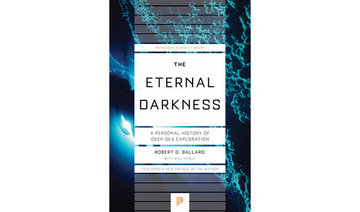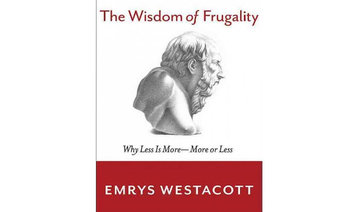How can you become one of the youngest women working as a deputy chief of staff for the president of the United States? How can you make it to the White House when you have no connections, and you have not even attended an Ivy League university?
In this fun-loving book, “Who Thought This Was a Good Idea,” a White House Official reveals a side of politics we never see.
She has written a sincere and gripping memoir of her years in Washington, which is also the inspiring story of someone very ordinary who managed to live an extraordinary life.
Mastromonaco also wrote this book to encourage women to work in the government because most of the people who work in politics are men and most political memoirs written are in turn by men.
Mastromonaco was an ordinary girl living an ordinary life. “I grew up in a town where you didn’t know who had money and who didn’t. The wealthiest families were probably the Equine Veterinarians, and they drove beat-up Suburbans and Wagoneers,” Alyssa wrote.
While studying for a French major, she became interested in politics and decided to apply for a summer internship with Bernie Sanders. She landed the internship and it gave her the first taste of politics and a valuable experience. Mastromonaco was quick to notice that Sanders met with constituents more than any other politician she’d known. He also showed her how to see the people whose problems he could immediately impact and solve. Sanders was also helped by staff who genuinely shared his desire and will to help the constituents.
This says Alyssa “is not necessarily true of other senators; many politicians have staff made up of climbers, who move from one senator to another to get up the ladder, with the ultimate goal of becoming a legislative director or chief of staff.” 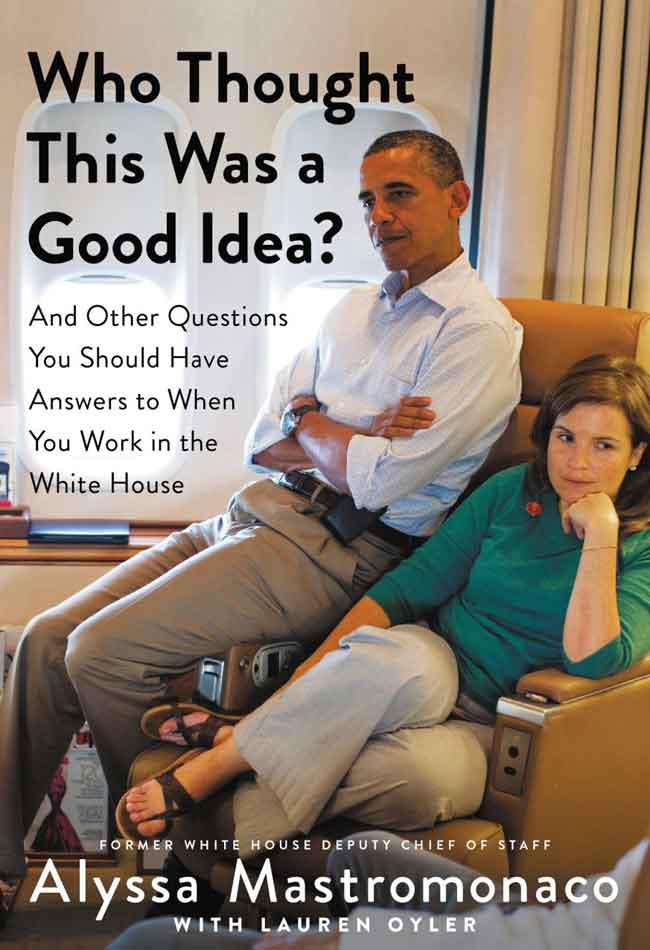
Although she didn’t get to interact very much with Bernie, she knew now that she wanted to work in the government. After her graduation, she did a brief stint at Merrill Lynch and in the spring of 2000, she was finally offered the position of assistant to the press department and scheduler thanks to a convincing and passionate plea for a job addressed to John Kerry’s intern coordinator. She worked on and off for four years and, connections are always useful. Robert Gibbs, who had quit the Kerry campaign to work on Obama’s US Senate race, came at the right time with a job proposal, as director of scheduling. Alyssa thought Obama, who was practically unknown at the time, would be thrilled that someone with experience, charm and talent would want to work for him. Mastromonaco was wrong: “Barack Obama is tougher than that. He cared less about my credentials and more about the fact that I wasn’t from Illinois,” she said. After some persuading, Obama offered her the job.
Four years after she started working for Obama, and just days before the general election, Obama was due to appear in an event in Chester, Pennsylvania. The weather forecast was bleak and Republican Sen. John McCain had canceled all his events. Obama is not fond of the cold but according to Mastromonaco, “how better to show contrast with an old and tired Senator McCain than with a spry and virile Barack Obama, so dedicated to the American public that he would endure a snowstorm to tell them about his vision for the country?”
So, the Chester event was kept on the schedule. The weather as predicted was awful. The meeting was televised, and it showed a charismatic and courageous Obama with his face smacked by sleet. At the end of his speech, Obama made a phone call: “Alyssa, it’s Obama. The event looked AWESOME! You heard John McCain canceled all of his events, right? He looked like a total old man.
“Alyssa, where are you right now?”
“My desk”
“Must be nice.”
A week later, Obama had won the general elections, carrying the District of Columbia, and 28 states, including Pennsylvania. Damon Winter, a photographer from the New York Times, received a Pulitzer Prize for his coverage of the presidential campaign and the winning work included a photo of the Chester event.
“I first walked through the gates of the White House about a month before Obama took office and I would officially start working there. I was going to be the assistant to the president for scheduling and advance... Assistant to the president is the most coveted position in the White House; there are only about 20 to 25 of them at any one time. I was one of the youngest women to ever hold that title, if not the youngest,” wrote Mastromonaco.
This behind-the-scenes memoir shows us that high-level meetings are not always as organized as they should be. A UN Climate Change Conference was due to take place in Copenhagen and it was not clear whether the negotiations would be ready for heads of state to participate. The decision to attend was made just a week before the convention. It was a tight schedule with an early morning arrival in Copenhagen and a departure immediately after the end of the conference.
President Obama had requested to meet Chinese Premier Wen as well as Brazilian president Lula da Silva, the Indian prime minister Manmohan Singh, and South African President Jacob Zuma. By the afternoon, nobody had responded and to make matters worse, nobody knew where the delegations were except for the Indian delegation, which had apparently already left for the airport. At that point, Hillary Clinton who was heading the negotiations wanted to know if the Indian delegation had really left. Soon after, the news broke out that the Indians and all the missing delegations were attending a secret meeting organized by Chinese Premier Wen. President Obama and Secretary Clinton walked immediately to the conference room. Obama passed in front of shocked Chinese officials and entered the room, exclaiming “Premier Wen! Are you ready for me?” Secretary Clinton recounts in her memoir that she “ducked under” the Chinese guards to make it inside. All the people attending were flabbergasted, but Obama finally held his meeting and even clinched an agreement after an hour and a half. In the meantime, a snowstorm was threatening Washington; if there was too much delay, Andrews Air Force Base would close down.
“Even though pretty much everyone disagreed with me, I made them wait. The situation was tense and the stakes were so high that I knew we had to give the president as much time as he needed… we took off out of Copenhagen two and a half minutes before we would have been held up there because of weather. Persistence will get you far and leaders have to champion the push,” explained Mastromonaco.
Traveling with the president is not what we imagine. It certainly is not a holiday.
The schedule is so hectic that it is not even clear when one will eat.
Sometimes, a whole day goes by without food. In 2012, there was so much traveling that meetings would be held from AF1 or by phone in the motorcade.
When Mastromonaco was promoted to deputy chief in January 2011, her personal life changed. She was at work at 6:45 in the morning and back home at 8 p.m.. She stopped going out and making plans because something could come up at any moment of any day. When Mastromonaco was not in the office, she was at home waiting beside two secure phones and a secure computer.
For almost a decade Mastromonaco, who is now president of global communications strategy and talent at A+E Networks, worked hard. Most people leave the White House after three years because it drains you.
“Working in the White House is incredible, but it is also completely, totally exhausting and exhausting isn’t even descriptive enough,” wrote Mastromonaco.
“I loved being part of an administration that I thought was making the country better…Plus when I traveled for work, I took Air Force One…and instead of wasting time at boring conference centers, I was doing things like eating goat in the courtyard of Hamid Karzai’s palace.”
But there comes a time when even beautiful memories cannot prevent even the most dedicated aides from becoming irritable and angry. The stress was taking its toll. For Alyssa Mastromonaco, who was listed in 2011 as amog Washington’s most powerful, least famous people, it was time to leave.
On her last day at the White House, she gave in her security badge, promised not to talk about anything classified, packed all her boxes in her car including a painting of a landscape in Iowa, a present from Obama, and drove away.
Mastromonaco had finally quit a high-power job but could she ever forget the feeling and satisfaction it gave her? “I can do a lot, and I know that I have to. Besides, if I’m being completely, totally honest, there are a couple of (female) politicians out there whose work I really, really believe in. If any of these women ever decided to make a big run, and if they thought I could serve them well, I would have a very hard time saying no.”
—
Email: [email protected]
Book Review: The rare art of sincerity in Washington politics
Book Review: The rare art of sincerity in Washington politics
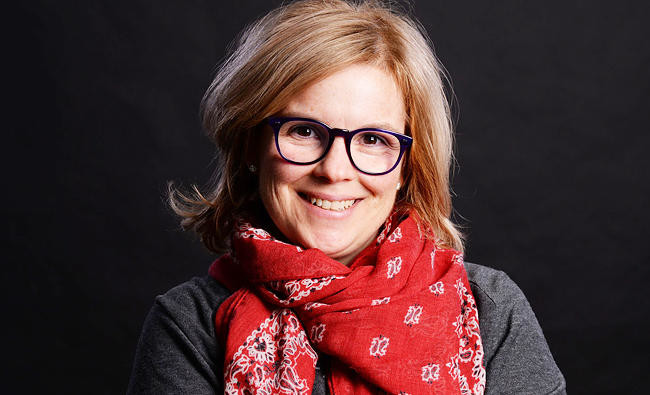
Saudi Film ‘Hajjan’ wins 6 nominations at Critics Awards for Arab Films
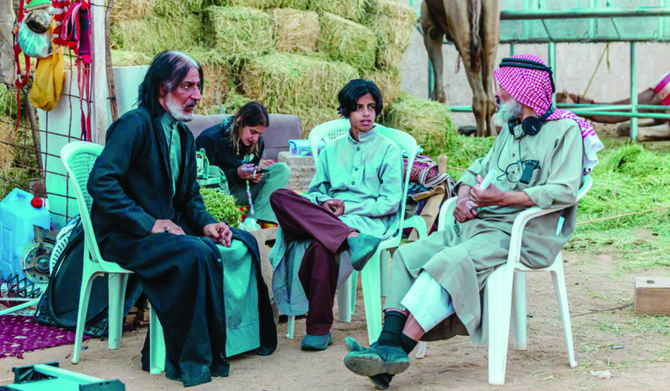
DUBAI: Saudi Arabia-based film “Hajjan,” directed by Egyptian filmmaker Abu Bakr Shawky, is nominated for six categories at the eighth Critics Awards for Arab Films.
The movie is competing in the best feature film, best screenplay, best actor, best music, best cinematography and best editing categories.
“Hajjan” tells the story of Matar, a boy who embarks on a journey across the desert with his camel, Hofira.
The movie is a co-production between the Kingdom’s King Abdulaziz Center for World Culture, or Ithra, and Egyptian producer Mohamed Hefzy’s Film Clinic.
The movie, which is written by Omar Shama from Egypt and the Kingdom’s Mufarrij Almajfel, stars Saudi actors Abdulmohsen Al-Nemer, Ibrahim Al-Hsawi, among others.
The awards ceremony, scheduled for May 18 on the sidelines of the Cannes Film Festival, is organized by the Arab Cinema Center in Cairo and assessed by a panel of 209 critics representing 72 countries.
Sudanese director Mohamed Kordofani’s inaugural feature film, “Goodbye Julia,” and Tunisian filmmaker Kaouther Ben Hania’s Oscar-nominated documentary, “Four Daughters,” scored nominations in seven categories.
Jordanian filmmaker Amjad Al-Rasheed’s “Inshallah A Boy” and Palestinian-British director Farah Nabulsi’s “The Teacher” have six nominations.
REVIEW: Sofia Boutella’s heroic efforts can’t save ‘Rebel Moon — Part Two’
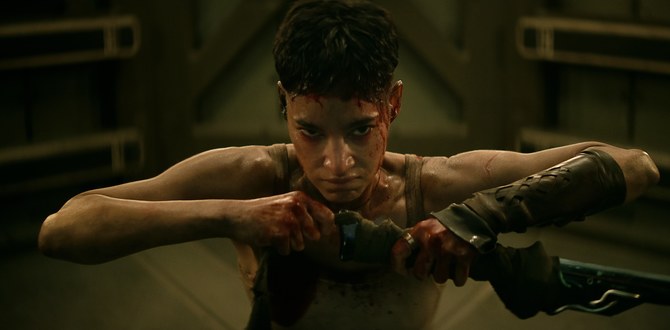
DUBAI: “Rebel Moon — Part One: A Child of Fire” drew scathing reviews (our writer described it as perhaps “the most discombobulating collection of mismatched sci-fi tropes ever committed to film”). “Part Two: The Scargiver” simply adds to that legacy.
The story: Former Imperium soldier Kora and the surviving band of ragtag warriors she’s recruited return to the moon of Veldt — home to simple farming folk in danger of being blown to bits by the mighty Imperium for failing to supply the unreasonable grain quota demanded of them. With just a few days before the deadline, Kora and her band must train the villagers to fight (and harvest the grain in just three days to provide a bargaining chip). What Kora doesn’t know is that Admiral Noble, the bad guy she ‘killed,’ is still alive. And bent on vengeance.
Before the enemy arrives, the warriors tell their life stories in a trust-building exercise — one of the clunkiest pieces of exposition ever written. There are slow-mo shots of the harvest gathering and a brief interlude to show that Kora and farmer Gunnar are very much in love.
Then, thankfully, we’re into the battle(s). Here, at least, director Zack Snyder doesn’t disappoint, even giving an original twist to the ‘spaceship plummeting from the sky’ trope by staging a showdown between Kora, Gunnar and Admiral Noble on a floor that becomes increasingly vertical. Below them, the villagers fight heroically against odds very much stacked against them, even with the help of Nemesis and her two flaming definitely-not-lightsabers.
The well-constructed battle scenes, though, aren’t enough. Not even with a cast fighting as heroically as the villagers to salvage something. Sofia Boutella, as Kora, emerges with most credit, proving herself a convincing action hero who deserves better than this material to work with (spoiler alert: perhaps even material that allows the heroine to kill the bad guy herself, without the intervention of her boyfriend).
Yes, no one’s sitting down to watch an “epic space opera” in the expectation of thought-provoking dialogue, but “Rebel Moon” is like the result of forcing a seven-year-old to watch all things “Star Wars” and “Star Trek” in random order, then asking them to write down what happened. The best thing to say about “The Scargiver” is that it finishes — but even that comfort is tainted by Snyder’s cynical setting up of a potential part three. Possibly because that seven-year-old fell asleep before writing an actual ending.
Saudi Arabian history on display at Abu Dhabi Book Fair
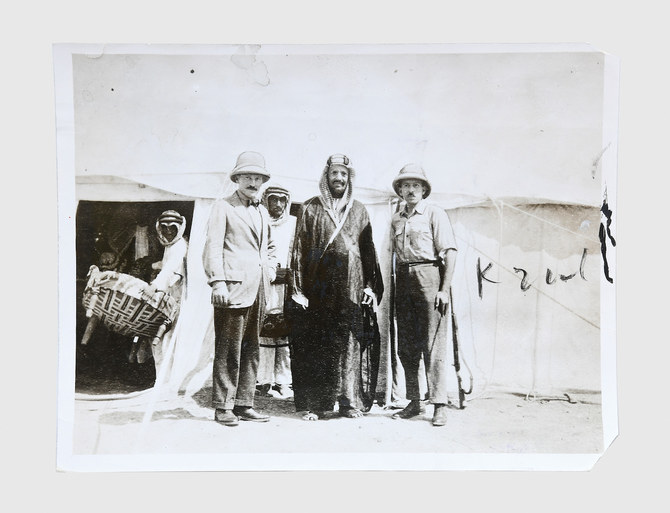
- Selections from London-based rare-book dealer Peter Harrington’s offering at the UAE fair
‘Ibn Saud press photograph’

According to notes from rare books specialists from Peter Harrington’s team, this image from archives of The Times newspaper was taken in what was then called Hejaz, following a “critical and secretive meeting between (founder of Saudi Arabia) Ibn Saud (center) and the British representative Sir Gilbert Clayton (left) — one of a pivotal series of negotiations which led to the Treaty of Jeddah in May 1927.” The two discussed “various outstanding questions affecting the relations of the Kingdom of the Hejaz and Nejd with the neighboring states of Iraq and Transjordan” to help determine the northern borders of Saudi Arabia. “Discussions over the borders were protracted and complex, with the towns of Maʿan and Kaf the object of particularly intense debate,” the notes state.
‘Pilgrimage to El-Medinah and Mecca’ by Richard F. Burton
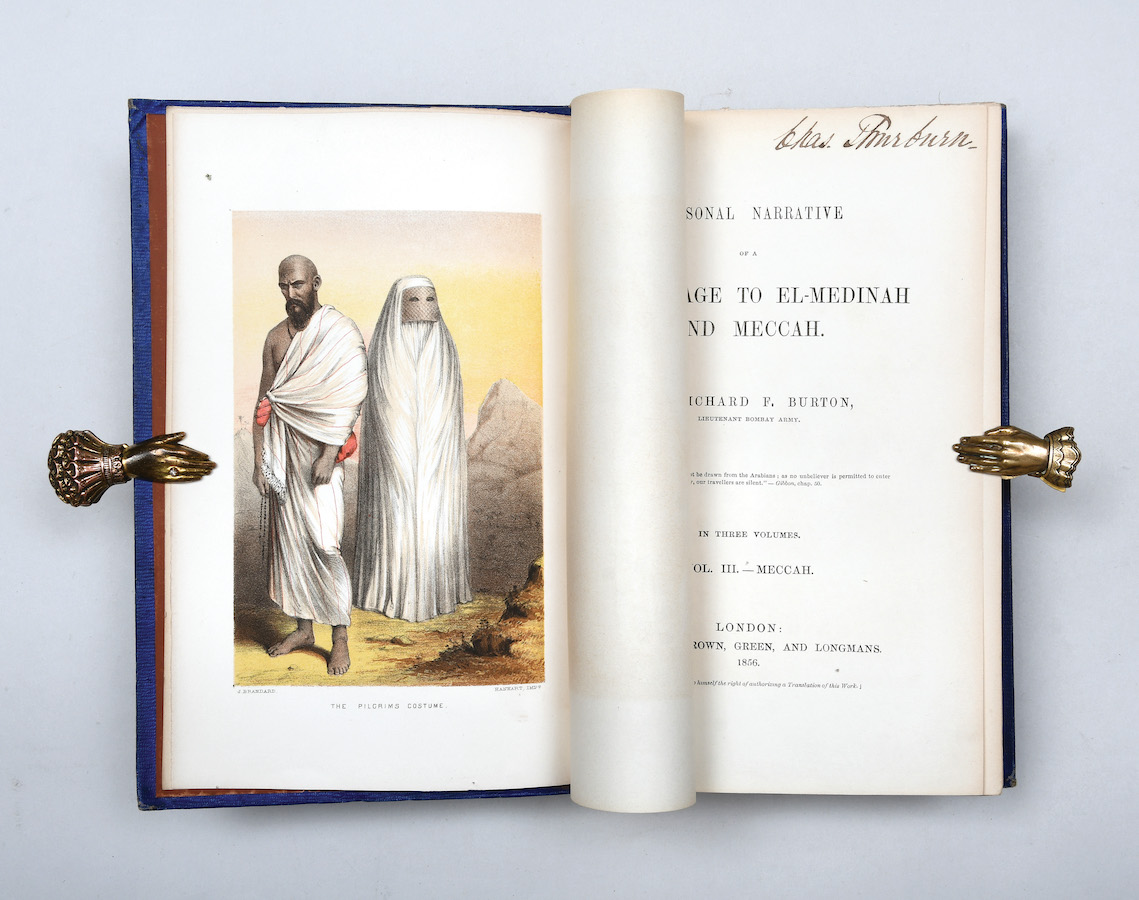
In this three-volume first edition, complete with illustrations, of “one of the most extraordinary travel narratives of the 19th century,” the British explorer, writer and polyglot Richard Francis Burton recounts his Hajj journey, made “in complete disguise as a Muslim native of the Middle East” at a time when fewer than half-a-dozen Europeans had made the pilgrimage — forbidden to non-Muslims. “It surpassed all preceding Western accounts of the holy cities of Islam, made Burton famous, and became a classic of travel literature, described by T. E. Lawrence as ‘a most remarkable work of the highest value,’” the team from Peter Harrington note. In Makkah, Burton performed all the rites of the pilgrimage and his subterfuge remained undiscovered.
‘Map and Overview Presenting the Hejaz Railway Route’

This map from 1903 depicts the route of the ambitious Hejaz Railway project. It “depicts a very broad area, extending from just north of Hama, Syria, all the way south a little way past Makkah, in the Hejaz; it covers most of Syria, all of Palestine, the Sinai Peninsula, the Suez Canal, and all the north-western Arabian Peninsula,” Peter Harrington’s rare book experts write. “It clearly delineates those parts of the railway that are in place and those under construction … with each station labelled. Additionally, it depicts the two alternative routes proposed for extending the line to Makkah, employing broken lines, while another line traces the proposed (but unrealized) route of a rail line from Makkah to Jeddah. The map also labels important roads and caravan routes.”
Four years after this map was published, the book seller’s notes state, the railway reached AlUla, which is not marked on this map, although Mada’in Salah (now Hegra) is, which today is the site of one of two museums dedicated to the Hejaz Railway.
By 1908, the railway had reached Madinah, where, the notes state, “for various political reasons, it had to be terminated.” Nevertheless, they continue, “until the outbreak of the First World War, it allowed hundreds of thousands of pilgrims to make the Hajj in safety and with relative ease.”
‘Material from the library of Peter O’Toole by T.E. Lawrence’
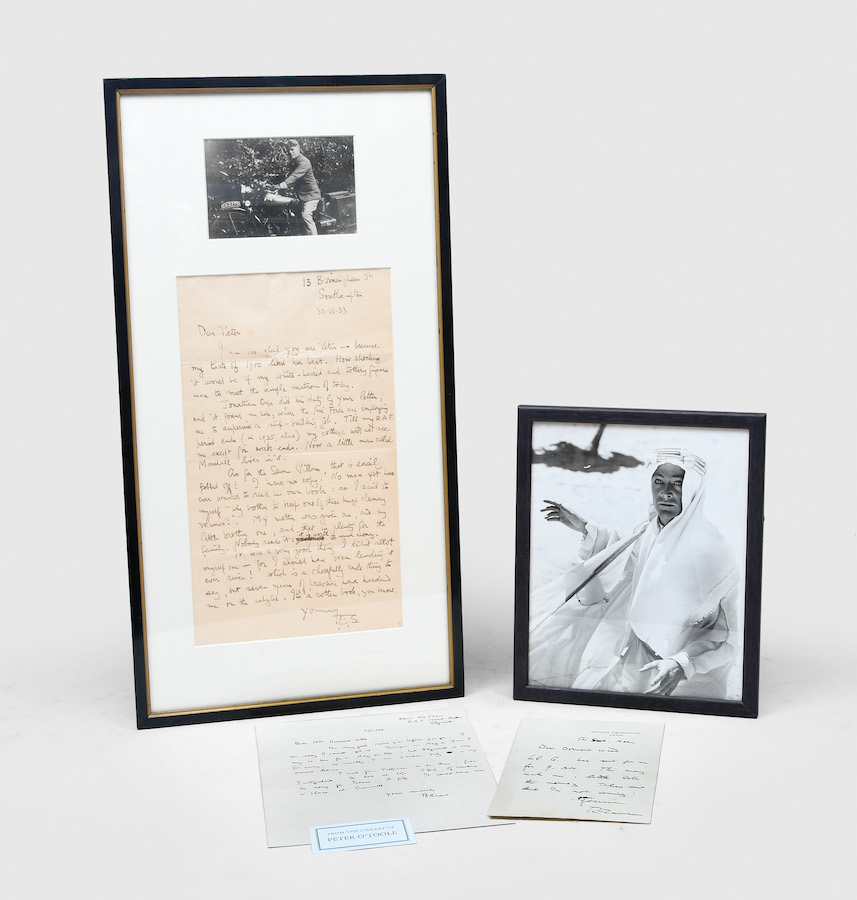
Billed by Peter Harrington as an “insightful archive, spanning Lawrence’s transformation from man of the moment to unwilling celebrity, from the library of Peter O’Toole, whose breakthrough portrayal in David Lean’s 1962 biopic still shapes perceptions of the famous Arabist. Autograph material from Lawrence is always highly prized, but rarely is its provenance so apposite.”
The centerpiece of the material is a photograph and an unpublished letter written by Lawrence (who became known as Lawrence of Arabia following his journeys across the Middle East, including modern-day Saudi Arabia), framed as a piece and gifted to the English actor who played Lawrence in the aforementioned biopic by his wife, Sian, and a friend not long before the premiere of the movie. The letter makes clear Lawrence’s difficult relationship with his celebrity, and is cutting about his own book, “The Seven Pillars of Wisdom,” saying that he did not own a copy himself (“No man yet has ever wanted to read his own book”) but that his mother and “little brother” did, “and that is plenty for the family. Nobody reads it: it is worth too much money. ... It is a rotten book, you know.”
‘Oil Region in the Desert of Saudi Arabia’
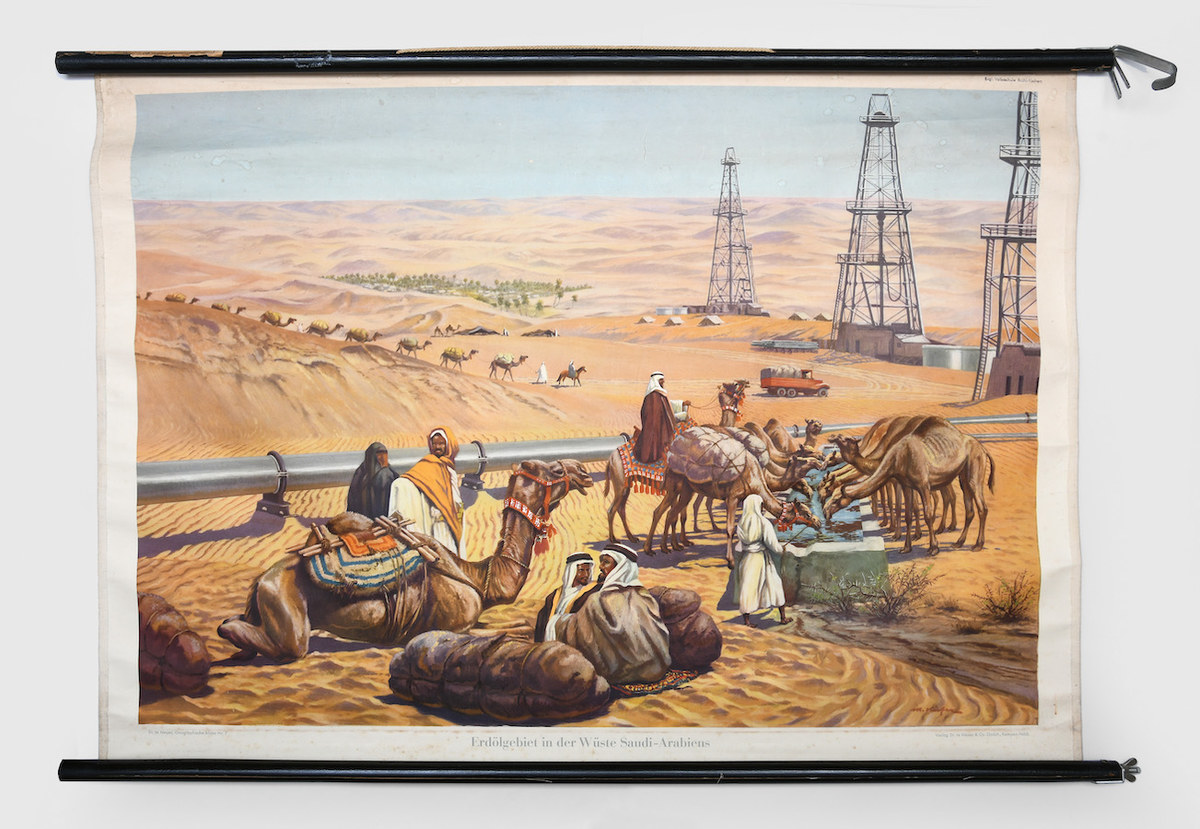
This 1950 image, “after a painting by the German artist Michael Mathias Kiefer,” is one of a series of geographical pictures intended for use in the curriculum of German schools. “The painting juxtaposes Arab figures in traditional garb with images of drilling rigs, a lorry, and oil storage tanks, creating a strikingly orientalist image,” Peter Harrington’s notes state. “In the middle of the composition, a pipeline bisects the image, a forceful reminder of the centrality of oil to the modern Saudi Arabian economy. In the foreground, members of a group of travelers, possibly intended to be Bedouins, rest on a carpet and let their camels drink from a water tank. Away in the background, before a distant oasis, more travelers arrive at a campsite, their camels heavily laden. Their destination is the oil infrastructure that crowds the right of the image.”
An enduring bond: A Jordanian photographer has turned his focus on two of the Arab world’s most beloved creatures

- Tariq Dajani’s first photographic exhibition of the horse and falcon series is on display at Ahlam Gallery in Al-Olaya, Riyadh
- Arabian horses have been the subject of songs and poetry praising their individual and physical qualities down through the ages
RIYADH: The Arabian horse and hunting falcon are important historical and cultural symbols for the Arab world, both ancient and modern.
Now a Riyadh gallery is highlighting this enduring bond with a series of portrait studies of both creatures by Tariq Dajani, a Jordanian photographer and printmaker.
Arabian horses have been the subject of songs and poetry praising their individual and physical qualities down through the ages.
However, Dajani, an owner of Arabians, chose to reflect his love of these creatures through photography and artworks.

Over the years he spent many sessions photographing horses in his native Jordan, as well as the UAE and Saudi Arabia. Later, toward the end of the project, he added the hunting falcon, another symbol of cultural heritage and pride among Arabs.
Dajani’s first photographic exhibition of the horse and falcon series is on display at Ahlam Gallery in Al-Olaya, Riyadh.
Entitled “Drinkers of the Wind,” the exhibition is the result of 16 years’ work creating portraits of these magnificent creatures.

Dajani told Arab News that he is delighted to be able to display his work in Saudi Arabia, “a country that is deeply connected to the horse and the falcon.”
Ahlam Gallery is the perfect place to showcase these artworks, he added.
Dajani’s treatment of his subjects is not in the usual natural or romantic manner. Instead, and this is partly what sets his art apart, he uses a studio portrait approach, where he takes his studio to the stables or falcon sheds, and spends time carefully working on portrait studies of the creatures.
“My aim is to find a connection of sorts with the horse or the birds,” he said. “I am not interested in documenting the creature; I try to go deeper, to express something emotionally if I can.
“I was living in Sweden when I decided to photograph the Arabian horse. So I had to return to the Middle East, and I started with Jordan, my home country.
“The way I approach the work is to present the horse on a backdrop where all my focus — and thus the viewers of the final picture — will be on the animal itself and not on the environment that it is in.”

While photographing in Jordan, Dajani met Princess Alia Al-Hussein, eldest daughter of the late King Hussein of Jordan. He presented some of his work to her, and received her enthusiastic approval.
Princess Alia gave him permission to photograph the horses of the Royal Jordanian Stud, and has continued to support his work over the years, opening his first two exhibitions in Jordan.
“I had access to some of the most beautiful horses in Jordan when I first started my project. My first exhibition solely of Jordanian Arabians was a great success,” Dajani said.
“Encouraged by the reception, and by now totally absorbed in this project, I went to Dubai, then Abu Dhabi, then Saudi Arabia, where I was presented with some of the most magnificent Arabian horses to photograph. Along the way, I introduced portrait studies of the hunting falcon. They, too, are strikingly beautiful and have a special place in Arab culture and heritage.
“I will always remain very grateful to Princess Alia for her initial support, and to many others for encouraging the work and opening doors for me along the way.”

One of his most striking photographs shows two mares bringing their heads together in a gentle greeting.
“This incredible and totally unanticipated greeting happened while I was photographing at the King Abdulaziz Arabian Horse Center in Dirab, south of Riyadh. The two mares were led out onto my backdrop studio space from opposite sides, and when they approached each other, they gently and courteously touched their heads as if to say hello,” he said.
“It was so special. No one had ever witnessed this before. We all held our breath as we watched in amazement. I frequently think that it would be nice if these sensitive, clever creatures could teach us humans a little bit of gentleness and respect.”
Dajani’s exhibition features high-quality photographic color prints, and a smaller collection of photogravure prints, produced by manually pulling an inked metal plate, engraved with the photographic image, through a traditional printing press — a slow and difficult process that produces prints with a special feel and texture.
Moroccan director Asmae El-Moudir joins Cannes’ Un Certain Regard jury

DUBAI: The Cannes Film Festival announced on Thursday that Moroccan director, screenwriter and producer Asmae El-Moudir will be part of the Un Certain Regard jury at the 77th edition of the event, set to take place from May 14-25.
She will be joined by French Senegalese screenwriter and director Maïmouna Doucouré, German Luxembourg actress Vicky Krieps and American film critic, director, and writer Todd McCarthy.
Xavier Dolan will be the president of the Un Certain Regard jury.
The team will oversee the awarding of prizes for the Un Certain Regard section, which highlights art and discovery films by emerging auteurs, from a selection of 18 works, including eight debut films.
El-Moudir is the director of the critically acclaimed film “The Mother of All Lies.”
The movie took the honors in the Un Certain Regard section, as well as winning the prestigious L’oeil d’Or prize for best documentary at the festival in 2023. The film explores El-Moudir’s personal journey, unraveling the mysteries of her family’s history against the backdrop of the 1981 bread riots in Casablanca.
El-Moudir is not the only Arab joining the Cannes team.
Moroccan Belgian actress Lubna Azabal this week was appointed the president of the Short Film and La Cinef Jury of the festival. The La Cinef prizes are the festival’s selection dedicated to film schools.


